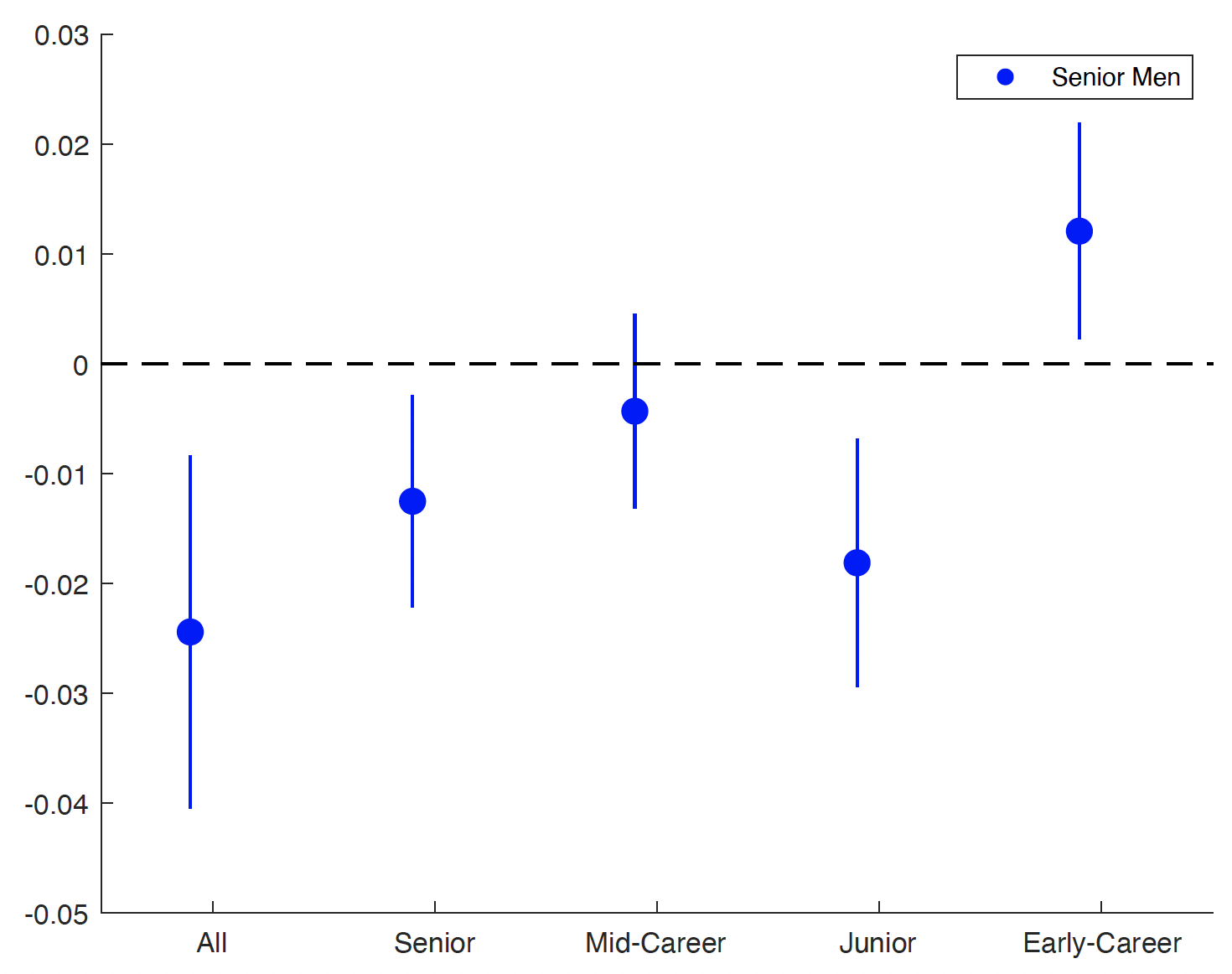Scientific collaboration is a cornerstone of research, facilitating the exchange of ideas, knowledge, and methodologies. Moreover, it builds intergenerational links, with senior researchers playing a key role in mentoring young scholars by offering guidance, support, and opportunities to expand their networks. Recent studies highlight that collaborations with more coauthors and gender diversity tend to produce more impactful work (Maddi and Gingras 2021, Anderson and Richards-Shubik 2022). Any disruption to the incentives for collaboration can affect researchers’ productivity, job prospects, and career advancement, with varying effects based on career stage and the size and strength of coauthorship networks.
In October 2017, the MeToo movement gained international momentum, increasing awareness around issues of gender discrimination and harassment in the workplace. By 2018, the economics profession had faced its own MeToo moment, with abundant evidence of discrimination and harassment.
This development could have altered the nature and costs of research collaborations. On the one hand, the movement might have fostered a more respectful and inclusive environment, encouraging scrutiny of male-dominated fields and pushing for greater diversity and inclusivity in the scientific community. On the other hand, it might have introduced a cautious approach to forming new collaborations, making some researchers hesitant to work with researchers outside their network, from either a lack of trust or the fear of damaging their reputations.
Analysing collaboration shifts: Insights from CEPR and NBER working papers
We set out to investigate the impact of the MeToo movement on coauthorships within economics, analysing working papers from the Centre for Economic Policy Research (CEPR) and the National Bureau of Economic Investigation (NBER), from January 2004 to December 2020. Our analysis (Amano-Patiño et al. 2024) is carried out from the vantage point of an author in a paper. We look for shifts in the composition of coauthors for each paper of a given author, post MeToo, by seniority and gender.
Our analysis differentiates between coauthorship relationships that were already established and those formed anew, examining how these dynamics evolved in response to the MeToo movement. Our strategy is to examine how, in a given paper, the shares of coauthors by gender and seniority have been affected by MeToo after controlling for a comprehensive set of controls including time fixed effects, the number of authors per paper, and the field of study. For this purpose, we employed a subsample of the dataset collected for Project CAPER and used in Amano-Patiño et al. (2020).
For each paper, we have the title, publication date, JEL codes, and author names, and have complemented the controls to incorporate author characteristics such as years of professional experience, number of past coauthors, number of previous papers, average number of coauthors per paper, and measures of the size of their collaboration network as represented by their involvement in papers published in the two series. The final dataset consists of 46,449 author-paper observations, with 8,117 distinct authors and 24,240 distinct papers from CEPR and NBER. Of the total authors, 6,308 are men and 1,809 are women.
The impact of MeToo on collaborations
Our empirical analysis uncovers a substantial shift in collaborative patterns compared to pre-MeToo averages. First, collaborations across genders have increased: we estimate a 12.5% increase of women coauthors per 100 men-authored papers.
However, we also find sizable decreases in coauthorships between senior and junior authors, irrespective of gender, and an increase in collaborations across genders of authors of the same seniority. Figure 1 shows the marginal effects of MeToo on coauthorships of senior and junior men authors with women authors, with 90% confidence intervals: for senior men (depicted in blue) we estimate an increased share of coauthorships with senior women, and a decreased share of coauthorships with junior women. At the other end, for junior men (depicted in orange) we estimate a decreased share of coauthorships with senior women, and an increased share of coauthorships with junior women.
Figure 1 Marginal effects of MeToo on coauthorships of senior and junior men
Notes: Estimated marginal effects with 90% confidence intervals of MeToo on shares of coauthorships of senior men authors (blue) and junior men authors (orange), using CEPR and NBER working papers from 2004 to 2020.
Second, our data indicate a general decline in new coauthorships, with an estimated average of nearly 5% fewer new coauthorships per 100 papers. This trend is observed predominantly for senior men authors, who now initiate significantly fewer new coauthorships across almost all seniority levels (apart from early-career economists), and especially so with junior women, as shown in Figure 2. Generally, senior researchers reduced their new collaborations with junior women by an estimated 33% for every 100 senior-authored papers. These results complement those of Gertsberg (2022), who focuses on collaborations with junior academic women in the top US departments.
Figure 2 Marginal effects of MeToo on new coauthorships of senior men
Notes: Estimated marginal effects with 90% confidence intervals of MeToo on shares of new coauthorships of senior men authors, using CEPR and NBER working papers from 2004 to 2020.
Our robustness checks confirm these results. They include variations of the samples we work with, the number and type of control variables we use, the specification of our regression equation, the timing of the MeToo movement, etc. The identified effects are robust, giving strong support to our main findings, with a clear message: post-MeToo, there has been an increase in sorting by seniority and a decrease in sorting by gender.
Accounting for the Covid-19 effect
Given that MeToo had a positive effect on how men and women authors collaborate, we also explored whether this continued to be the case at the onset of the Covid-19 pandemic. The pandemic was a big shock that significantly altered work dynamics, impacting collaboration in economic research. While productivity temporarily surged, it was unevenly distributed across genders (see Amano-Patiño et al. 2020, Deryugina et al. 2021, Barber et al. 2021, Squazzoni et al. 2020, Kruger et al. 2022). Virtual collaboration had the potential to facilitate new partnerships across seniorities, yet women, especially those with young families, faced challenges to their productivity. Examining the impact of the pandemic on coauthorships suggests a slight benefit for younger and less established researchers. Our analysis indicates, however, that there was a partial reversal of the post-MeToo increase in collaborations across genders, particularly between men and junior women. Conversely, women experienced an increase in new coauthorships. These findings suggest a slowdown in collaboration network expansion across genders and seniorities, possibly influenced by both the MeToo movement and the pandemic.
Taking stock
The MeToo movement catalysed significant changes in the collaborative landscape of economists, particularly evident in the surge of partnerships across genders. This result is good news for the economics profession, as it suggests that authors recognised that more diverse collaborations can be conducive to higher quality and more impactful research, as established by the literature (Anderson and Richards-Shubik 2022, Maddi and Gingras 2021). Despite these progressive shifts, our findings also unveil a concerning decline in the initiation of new collaborations outside authors’ existing networks. The decline is particularly pronounced for senior scholars, who initiated fewer new coauthorships with authors of all but early-career seniorities, and have substantially fewer new collaborations with junior women. This is bad news. This change in coauthorship patterns may have long-lasting consequences in the development of the careers of women economists and may further disrupt an already ‘leaky’ pipeline (Stearns and Lundberg 2018, Lundberg 2020, Galiani and Panizza 2020).
These results underscore the urgent need for sustained efforts to cultivate a supportive ecosystem and dismantle systemic barriers hindering the advancement of women and junior economists in the field. The economics profession must proactively foster a safe, inclusive environment by evaluating, monitoring, and educating on relevant issues.
References
Amano-Patiño, N, E Faraglia and C Giannitsarou (2024), “Economics Coauthorships in the Aftermath of MeToo”, CEPR Discussion Paper 18969.
Amano-Patiño, N, E Faraglia, C Giannitsarou and Z Hasna (2020), “Who is doing new research in the time of COVID-19? Not the female economists”, VoxEU.org, 2 May.
Anderson, K A and S Richards-Shubik (2022), “Collaborative Production in Science: An Empirical Analysis of Coauthorships in Economics”, Review of Economics and Statistics 104: 1241–55.
Barber, B M, W Jiang, A Morse, M Puri, H Tookes and I M Werner (2021), “What Explains Differences in Finance Research Productivity During the Pandemic?”, The Journal of Finance 76 1655–97.
Deryugina, T, O Shurchkov and J Stearns (2021), “COVID-19 Disruptions Disproportionately Affect Female Academics,” in AEA Papers and Proceedings 111, 164–68.
Galiani, S and U Panizza (2020), “Publishing and Measuring Success in Economics”, VoxEU.org eBook, 28 September.
Gertsberg, M (2022), “The Unintended Consequences of #MeToo-Evidence from Research Collaborations”, available at SSRN 4105976.
Kruger, S, G Maturana and J Nickerson (2022), “How Has COVID-19 Impacted Research Production in Economics and Finance?”, The Review of Financial Studies 36: 3348–81.
Lundberg, S (2020), Women in Economics, CEPR Press.
Maddi, A and Y Gingras (2021), “Gender Diversity in Research Teams and Citation Impact in Economics and Management”, Journal of Economic Surveys 35: 1381–404.
Squazzoni, F, G Bravo, F Grimaldo, D l García-Costa, M Farjam and B Mehmani (2020), “Only Second-Class Tickets for Women in the COVID-19 Race. A Study on Manuscript Submissions and Reviews in 2329 Elsevier Journals”, PLoS ONE, 16.
Stearns, J and S Lundberg (2018), “Women in economics: Stalled progress”, VoxEU.org, 18 December.








